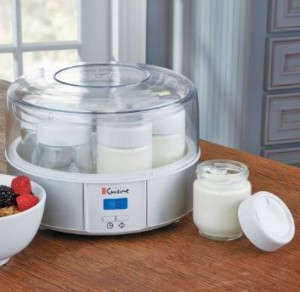It’s easy enough to head to a store and buy yogurt. After all, there’s a wide selection of yogurt in the dairy isle that’s difficult to ignore. But, you can actually make your own yogurt right at home. Even though it sounds difficult, it’s actually pretty easy—let’s take a look at it.
Making Yogurt at Home ~ Getting Started
Making yogurt at home is pretty easy. Okay, it requires some preparation, but once you’re done, it’s a sure process. You need equipment, supplies and enough space to keep your cultured yogurt steady in the fridge.
Getting started merely involves getting together your supplies and equipment. You actually don’t need complicated equipment, either.
 Should you use a yogurt maker?
Should you use a yogurt maker?
While many people readily make yogurt using pots, bowls and other supplies, others invest in what’s known as a yogurt maker.
Yogurt makers are small appliances that are designed to make yogurt. They’re especially noted for controlling the temperature needed to ensure the milk-yogurt culture mixture cultures properly and changes into thick yogurt.
You don’t exactly need a yogurt machine to make yogurt, but most people might find it easier to use one. That especially goes for people who plan on making fresh yogurt on a daily basis.
Most yogurt makers have a timer so you can schedule the start and have fresh yogurt every morning for breakfast!
Here, we’re going to look at a yogurt recipe that doesn’t necessarily use a yogurt machine. However, it can easily be adapted to fit one.
Making Homemade Yogurt ~ The Ingredients
Yogurt takes a few hours – about five – to incubate before it’s ready to eat. That’s why many people make this recipe before letting the mixture incubate overnight. Of course, before we get deeper into the process, let’s look at we need to make yogurt.
1 Quart Of Milk – Whole Milk
Whole milk is considered better to use for a thicker ‘standard’ yogurt, especially if you prefer a thicker yogurt. You can also use skim milk or low-fat milk, however they produce a thinner yogurt as a result. Thickeners like powdered dry milk can be used to thicken thinner yogurts. If you want to make dairy free yogurt, you should get coconut or soy milk for instance.
 3 Tablespoons Plain Yogurt With Active Cultures Or A Powdered Yogurt Starter
3 Tablespoons Plain Yogurt With Active Cultures Or A Powdered Yogurt Starter
If you can’t find a powdered yogurt starter, it’s easier to get yogurt with an active culture. These yogurts are usually tagged with such information, usually as healthy probiotics yogurt, so they’re not hard to find.
Flavorings – Any Kind
Once the yogurt is done, you’re welcome to add any flavorings that you like. The most popular include fruits (canned, fresh, frozen, cooked, etc), jam, honey, chocolate and caramel for sweeter yogurt. The yogurt can also be used in savory dishes in many ways, such as a marinade or sauce. It’s even a great substitute for fats in baking.
Making Homemade Yogurt ~ The Instructions
To make homemade yogurt without a yogurt machine, you’ll need:
- Bowls, preferably a large bowl or pot for culturing the yogurt and several small ones to store the yogurt after culturing.
- Small containers or jars, for storing the yogurt after culturing if bowls aren’t an option.
- Candy thermometer, for keeping track of the temperature.
- Saucepan, preferably one with a heavy bottom for scaling the milk.
- Towel, for wrapping around the bowl or pot where the yogurt will incubate while culturing, to keep it warm or at the right temperature.
Before you start, sterilize your equipment by pouring boiling water into each of the containers you plan to use for your yogurt. Wait 5 minutes, pour out the water and let the containers dry.
- Start by boiling your milk to 180 degrees. Use the thermometer to take the temperature as the milk heats. Once it reaches the right temperature, remove the pan from heat, keeping the thermometer in the pan.
- Wait for the temperature to drop to 115 degrees. As soon as it cools to that temperature, mix in the yogurt or the yogurt starter (tempered with milk) until it’s completely incorporated in the milk. Once that’s done, pour the mixture inside the sterile pot or container where the yogurt will culture.
- Cover the pot or container containing the mixture with a lid or plastic wrap. Keep the mixture stored in a warm place for about 10 to 12 hours. To keep the yogurt warm in a cooler place, wrap the towel around the pot or container to keep it warm. If you want a tangier yogurt, keep the yogurt stored for an additional 3 to 5 hours.
- Check the yogurt and refrigerate once it’s finished culturing. Let it cool for at least 3 to 4 hours before eating.
Making Homemade Yogurt: Closing Thoughts
As you can see, making homemade yogurt is not that difficult than what most people think. A yogurt maker will take all the effort out of your hands and will make your life a bit easier of course. Although there are some supplies that you do need to go out and get, everything used in this recipe can be purchased right at a department or grocery store.
This is the basic homemade yogurt recipe. If you want to make Greek yogurt, you can follow a few extra steps. It’s easy and also very tasty to eat!
Thanks for reading.
